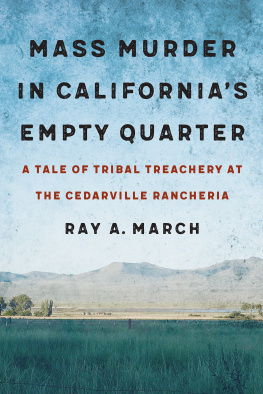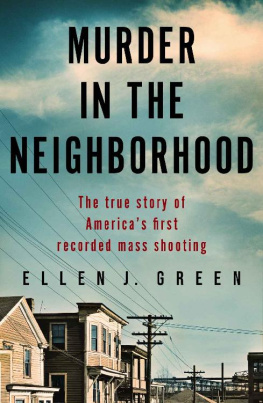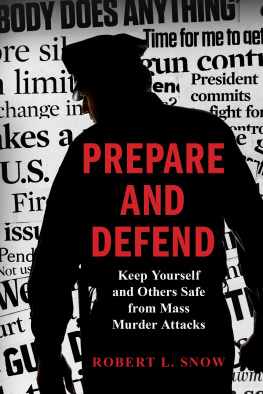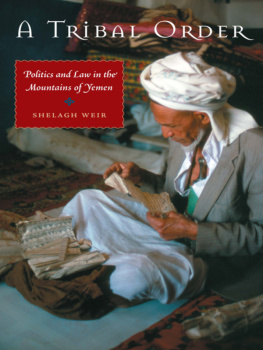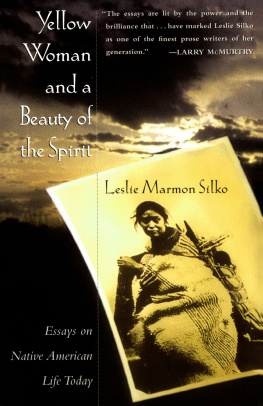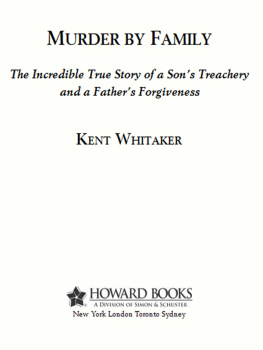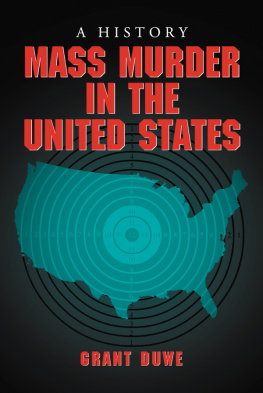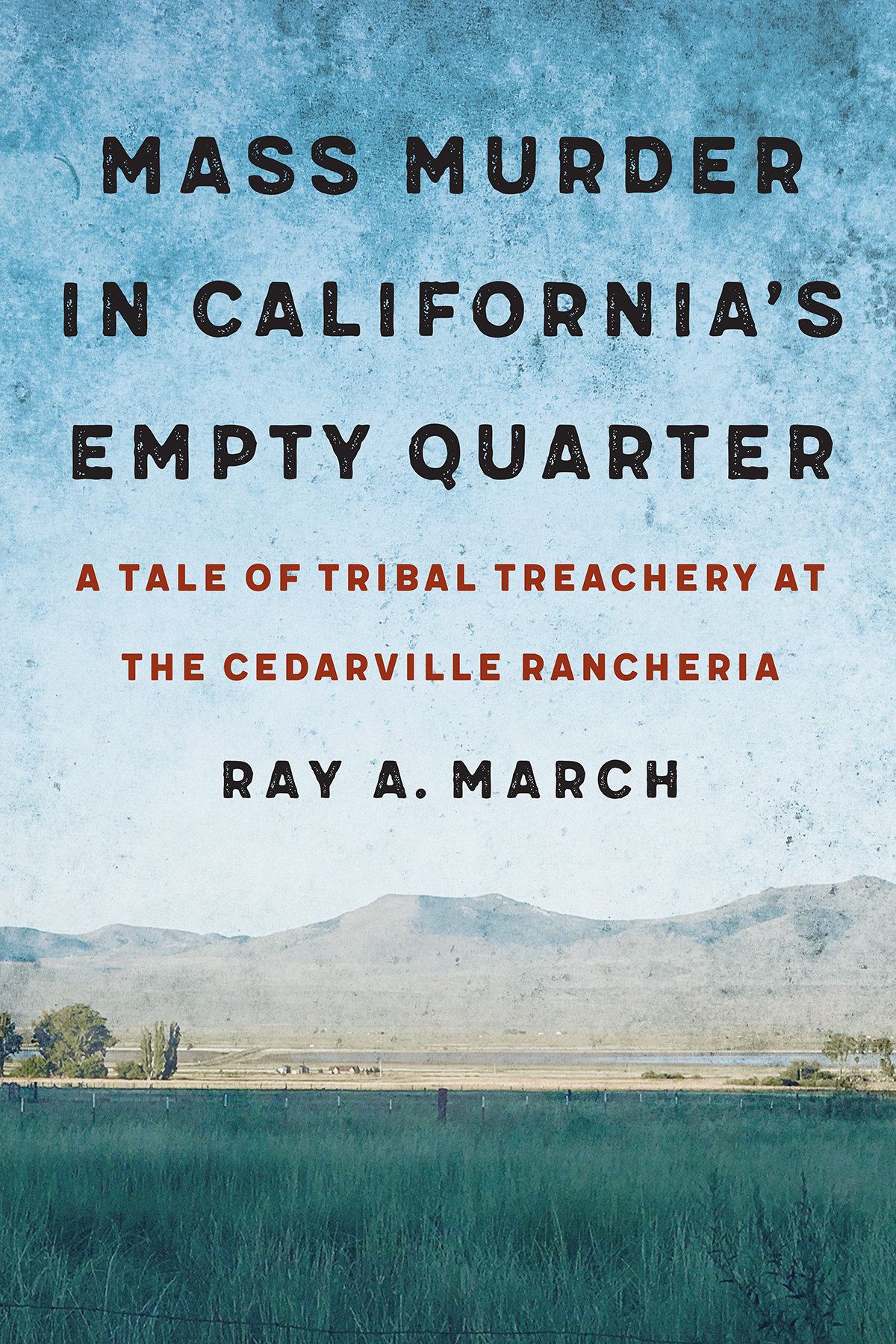
Ray A. March has written not just a compelling account of an otherwise little-noted mass murder on a Native American reservation in Northern California, he has made those brutal murders the starting point for a sensitive, complex, and thoroughly researched study of the politics and sociology of Native American life in twenty-first-century small-town America. In the course of telling this remarkable story, March investigates with a keen and knowing eye the underlying causes of the murders as well as their many ramications.
Stanley Cloud, author and former Washington bureau chief of Time magazine
In Mass Murder in Californias Empty Quarter Ray A. March brings careful research and considerable storytelling abilities to bear on a chilling story. The result is both a page-turner and a thoughtful consideration of how history, racism, identity, and bureaucratic failures fed the conflicts.
Jon Davis, founder and former director of the MFA program at the Institute of American Indian Arts

Mass Murder in Californias Empty Quarter
A Tale of Tribal Treachery at the Cedarville Rancheria
Ray A. March
University of Nebraska Press | Lincoln
2020 by Ray A. March
Cover designed by University of Nebraska Press; cover image: Hays range by Melissa Bailey.
Author photo Barbara Laiolo March.
All rights reserved.
Library of Congress Cataloging-in-Publication Data
Names: March, Ray A., 1934 author.
Title: Mass murder in Californias empty quarter: a tale of tribal treachery at the Cedarville Rancheria / Ray A. March.
Description: Lincoln: University of Nebraska Press, [2020] | Includes bibliographical references.
Identifiers: LCCN 2020010780
ISBN 9781496217561 (hardback)
ISBN 9781496224842 (epub)
ISBN 9781496224859 (mobi)
ISBN 9781496224866 (pdf)
Subjects: LCSH : Rhoades, Cherie. | MurderCedarville Rancheria, CaliforniaCase studies. | Northern Paiute IndiansCedarville Rancheria, CaliforniaCase studies. | Northern Paiute IndiansCedarville Rancheria, CaliforniaPolitics and governmentCase studies. | Cedarville Rancheria, CaliforniaHistory.
Classification: LCC HV 6533. C 2 M 185 2020 | DDC
364.152/34089974577079423dc23
LC record available at https://lccn.loc.gov/2020010780
The publisher does not have any control over and does not assume any responsibility for author or third-party websites or their content.
For Barbara, always
and
Kandi Maxwell and Lloyd Powell
and
in memory of
Darryl Babe Wilson
Achumawe-Atsugewi
(November 21, 1939May 4, 2014)
Jahomji is wearing his Pendleton trade blanket
While tribal sovereignty is limited today by the United States under treaties, acts of Congress, Executive Orders, federal administrative agreements and court decisions, what remains is nevertheless protected and maintained by the federally recognized tribes against further encroachment by other sovereigns, such as states.
An excerpt from the Bureau of Indian Affairs website
The politics in the land is still volatilea Molotov cocktail. I stand far from tribal politics because I see the 1934 Indian Reorganization Act as a most sinister piece of legislation. The contract tribes sign with the government is an an act of surrender, a surrender in terms written by the government. The contracts come with built-in diseases that infect only the tribal members.
Darryl Babe Wilson
Contents
Mass Murder in Californias Empty Quarter
When I told a few journalist friends I was writing a book about a mass murder that occurred in rural Northern Californiaa murder carried out by a Native American woman killing her own relativesI drew blanks. Were all so numbed by the stream of mass murders in this country that we brush off the flash headlines that dont set death toll records. One mass murder gets pushed off the front page by the next. The less spectacular are quickly forgotten or ignored. We know little of the story behind the story.
Mass Murder in Californias Empty Quarter is an expos of a family of urban Native Americans who took the Bureau of Indian Affairs up on its offer of free housing and federal funding and moved from the city to the reservation. Their displacement was a trial for which they were unprepared. They met lineal ancestry requirements for membership but they knew nothing of the Northern California Paiutes cultural heritage, traditions, spirituality, customs, or languageand predictably, they did not know the tribal laws that governed them. That created the storys outline but not its boundaries.
To research and write the story of the Cedarville Rancheria mass murder, I posed a theory: If conditions for Natives are to improve there must be a broad cross-cultural understanding of the challenges they face as they govern themselves under the rules of sovereignty. Following this line of this thinking, I delved into the systematic events that led to Cherie Rhoades killing half of her immediate family. I compared the U.S. laws Native Americans must follow as citizens of this country and the laws they must follow under their ownand contrastingtribal constitutions. One glaring difference I examined is the tribal use of sovereignty authority to purge its membership rolls. As the Cedarville Rancheria prepared to evict Cherie from the tribe there was an epidemic on the West Coast of what are known as disenrollments. Blood quantum was the measuring ruler for disenrolling families from their tribes. There is nothing comparable in the U.S. Constitution to this tribal stripping of citizenship. Discussion of blood quantum and who gets to be a Native American and who doesnt is in chapter 5.
As I prepared to write this book I sought opinions from the contacts I had in Indian Country. What did they think of a white guy writing a book about a mass murder and questions he had about their tribal laws and justice? Was there confidence among them that I could write a truthful and informative book? The reactions were lukewarm. The warmest, which I took as inspiration, went like this: I do not believe any research by a white guy would be accepted by Native people. That said, with years of listening to many opinions and tales, it would be effective for you to align with respected individuals to carry the face of the book.
Those respected individuals turned out to be Kandi Maxwell and her husband, Lloyd Powell. They gave me the reliable source support I needed in researching Mass Murder in Californias Empty Quarter. Kandi is Arkansas Cherokee and Lloyd is an enrolled Chickasaw. Not only did they willingly offer the credibility necessary to the work, they mentored me in the complexities of tribal law and provided intimate insights into Cedarville Rancheria life that were otherwise unobtainable. Under sovereignty status tribes are not obligated to conduct their business in public. I relied heavily on firsthand, for-the-record accounts, such as interviews and supporting documents of public record. Some interviews were conducted under the journalists ground rule of deep background, meaning the information could be used but the sources would not be revealed.
But Kandi and Lloyd knew the inner workings of the Cedarville Rancheria community. They knew Cherie Rhoades better than I did. My contact with Cherie was limited to the tribes Rabbit Traxx gas station. Ive recounted the Cherie and Rabbit Traxx episodes in chapter 3. Kandi and Lloyd knew the dysfunctions of the Rancheria. They knew the young Native students enrolled in Resources for Indian Student Education ( RISE ). On June 7, 2014, four and a half months after the killings, I met with them at their home west of Alturas and began a series of tape-recorded interviews. We quickly moved into the Native American world they called the haves and the have nots, tribes living in third-world poverty while others basked in wealth, the disenrollment wave that was hitting casino tribes, Cheries personality, her rivalry with her half-brother Rurik Davis, and the characteristics of her familythe Lashes.
Next page
